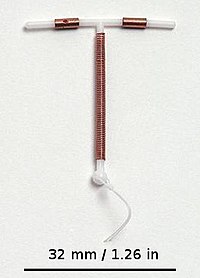
Photo from wikipedia
OBJECTIVE To compare the risk of all-cause death, hospitalizations (any cause), ectopic pregnancy, pelvic inflammatory disease or infection, uterine perforation, device removal, neuro-psychiatric drugs initiation, or new psychiatric visit(s) between… Click to show full abstract
OBJECTIVE To compare the risk of all-cause death, hospitalizations (any cause), ectopic pregnancy, pelvic inflammatory disease or infection, uterine perforation, device removal, neuro-psychiatric drugs initiation, or new psychiatric visit(s) between levonorgestrel (LNG) 52 mg intrauterine system (IUS) and copper intrauterine device (IUD) users in France. STUDY DESIGN We identified a historical cohort of women aged 20-55 years with a first dispensing of either LNG 52 mg IUS or copper-IUD between January 1, 2010, and December 31, 2014, in the French National Claims database, SNDS. We used propensity score matching to balance the two groups on baseline sociodemographic and clinical characteristics to minimize confounding. We estimated Cox proportional hazards models to compare health outcomes between LNG 52 mg IUS and copper-IUDs users. RESULTS We matched 9318 LNG 52 mg IUS users (mean age 36.2±6.8 years) to 10,185 copper-IUD users (mean age 35.4±7.1 years). After matching and age-adjustment, LNG 52 mg IUS users had a slightly higher risk of anxiolytic drugs initiation (HR 1.08, 95%CI 1.01-1.15) and device removal (HR 1.05, 95%CI 1.01-1.10) compared to copper-IUD users, with no differences for other studied outcomes. CONCLUSION French IUS users report slightly more anxiolytic treatment initiation and IUD removal compared to copper-IUD users. These results are consistent with a potential pharmacovigilance signal of anxiety-related disorders in LNG 52 mg IUS users. IMPLICATIONS STATEMENT In French LNG 52 mg IUS users, there was slightly more anxiolytic treatment initiation and IUD removal compared to copper-IUD users. No risk difference was found for all-cause death, hospitalizations, ectopic pregnancy, pelvic disorders, and uterine perforation. We cannot exclude that the associations are related to differences in characteristics of women who chose each type of type of IUD.
Journal Title: Contraception
Year Published: 2019
Link to full text (if available)
Share on Social Media: Sign Up to like & get
recommendations!